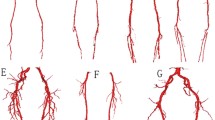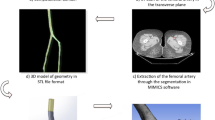Abstract
Computational numerical analysis was performed to elucidate the flow dynamics of femoral artery perfusion. Numerical simulation of blood flow was performed from the right femoral artery in an aortic model. An incompressible Navier–Stokes equation and continuity equation were solved using computed flow dynamics software. Three different perfusion models were analyzed: a 4.0-mm cannula (outer diameter 15 French size), a 5.2-mm cannula (18 French size) and an 8-mm prosthetic graft. The cannula was inserted parallel to the femoral artery, while the graft was anastomosed perpendicular to the femoral artery. Shear stress was highest with the 4-mm cannula (172 Pa) followed by the graft (127 Pa) and the 5.2-mm cannula (99 Pa). The cannula exit velocity was high, even when the 5.2-mm cannula was used. Although side-armed perfusion with an 8-mm graft generated a high shear stress area near the point of anastomosis, flow velocity at the external iliac artery was decreased. The jet speed decreased due to the Coanda effect caused by the recirculation behind sudden expansion of diameter, and the flow velocity maintains a constant speed after the reattachment length of the flow. This study showed that iliac artery shear stress was lower with the 5.2-mm cannula than with the 4-mm cannula when used for femoral perfusion. Side-armed graft perfusion generates a high shear stress area around the anastomotic site, but flow velocity in the iliac artery is slower in the graft model than in the 5.2-mm cannula model.





Similar content being viewed by others
References
Lillehei CW, Cardozo RH. Use of median sternotomy with femoral artery cannulation in open cardiac surgery. Surg Gynecol Obstet. 1959;108:706–14.
Dewall RA, Levy MJ. Direct cannulation of the ascending aorta for open-heart surgery. J Thorac Cardiovasc Surg. 1963;45:496–9.
Navia JL, Cosgrove DM 3rd. Minimally invasive mitral valve operations. Ann Thorac Surg. 1996;62:1542–4.
Saunders PC, Grossi EA, Sharony R, Schwartz CF, Ribakove GH, Culliford AT, Delianides J, Baumann FG, Galloway AC, Colvin SB. Minimally invasive technology for mitral valve surgery via left thoracotomy: experience with forty cases. J Thorac Cardiovasc Surg. 2004;127:1026–31.
Grossi EA, Loulmet DF, Schwartz CF, Solomon B, Dellis SL, Culliford AT, Zias E, Galloway AC. Minimally invasive valve surgery with antegrade perfusion strategy is not associated with increased neurologic complications. Ann Thorac Surg. 2011;92:1346–9.
Chan EY, Lumbao DM, Iribarne A, Easterwood R, Yang JY, Cheema FH, Smith CR, Argenziano M. Evolution of cannulation techniques for minimally invasive cardiac surgery: a 10-year journey. Innovations (Phila). 2012;7:9–14.
Murzi M, Cerillo AG, Miceli A, Bevilacqua S, Kallushi E, Farneti P, Solinas M, Glauber M. Antegrade and retrograde arterial perfusion strategy in minimally invasive mitral-valve surgery: a propensity score analysis on 1280 patients. Eur J Cardiothorac Surg. 2013;43:e167–72.
Jones TW, Vetto RR, Winterscheid LC, Dillard DH, Merendino KA. Arterial complications incident to cannulation in open-heart surgery with special reference to the femoral artery. Ann Surg. 1960;152:969–74.
Tanemoto K, Kuinose M, Kanaoka Y. Complications of femoral artery cannulation in aortic arch related operations (In Japanese). Nihon Kyobu Geka Gakkai Zasshi. 1994;42:306–10.
Palmer BV, Mercer JL. Anterior tibial compartment syndrome following femoral artery perfusion. Thorax. 1973;28:492–4.
Baribeau YR, Westbrook BM, Charlesworth DC, Maloney CT. Arterial inflow via an axillary artery graft for the severely atheromatous aorta. Ann Thorac Surg. 1998;6:33–7.
Minakawa M, Fukuda I, Inamura T, Yanaoka H, Fukui K, Daitoku K, Yanaoka H, Inamura T. Hydrodynamic evaluation of axillary artery perfusion for normal and diseased aorta. Gen Thorac Cardiovasc Surg. 2008;56:215–21.
Svensson LG, Blackstone EH, Rajeswaran J, Sabik JF 3rd, Lytle BW, Gonzalez-Stawinski G, Varvitsiotis P, Banbury MK, McCarthy PM, Pettersson GB, Cosgrove DM. Does the arterial cannulation site for circulatory arrest influence stroke risk? Ann Thorac Surg. 2004;78:1274–84.
Benim AC, Nahavandi A, Assmann A, Schubert D, Feindt P, Suh SH. Simulation of blood flow in human aorta with emphasis on outlet boundary conditions. Appl Math Model. 2011;35:3175–88.
Morris L, Delassus P, Callanan A, Walsh M, Wallis F, Grace P, McGloughlin T. 3-D numerical simulation of blood flow through models of the human aorta. J Biomech Eng. 2005;127:767–75.
Shahcheraghi N, Dwyer HA, Cheer AY, Barakat AI, Rutaganira T. Unsteady and three-dimensional simulation of blood flow in the human aortic arch. J Biomech Eng. 2002;124:378–87.
Yull Park J, Young Park C, Mo Hwang C, Sun K, Goo Min B. Pseudo-organ boundary conditions applied to a computational fluid dynamics model of the human aorta. Comput Biol Med. 2007;37:1063–72.
Vanierschot M, Van den Bulck E. The influence of swirl on the reattachment length in an abrupt axisymmetric expansion. Int J Heat Fluid Flow. 2008;29:75–82.
O’Keeffe ST, Woods BO, Breslin DJ, Tsapatsaris NP. Blue toe syndrome, causes and management. Arch Intern Med. 1992;152:2197–202.
Price DL, Harris J. Cholesterol emboli in cerebral arteries as a complication of retrograde aortic perfusion during cardiac surgery. Neurology. 1970;20:1209–14.
Crooke GA, Schwartz CF, Ribakove GH, Ursomanno P, Gogoladze G, Culliford AT, Galloway AC, Grossi EA. Retrograde arterial perfusion, not incision location, significantly increases the risk of stroke in reoperative mitral valve procedures. Ann Thorac Surg. 2010;89:723–9.
Ayyash B, Tranquilli M, Elefteriades JA. Femoral artery cannulation for thoracic aortic surgery: safe under transesophageal echocardiographic control. J Thorac Cardiovasc Surg. 2011;142:1478–81.
Hendrickson SC, Glower DD. A method for perfusion of the leg during cardiopulmonary bypass via femoral cannulation. Ann Thorac Surg. 1998;65:1807–8.
Acknowledgments
This study was supported by a grant from the Japanese Society for the Promotion of Science (Grant no. 24592044).
Author information
Authors and Affiliations
Corresponding author
Ethics declarations
Conflict of interest
The authors declare that they have no conflict of interest.
Rights and permissions
About this article
Cite this article
Kitamura, S., Shirota, M., Fukuda, W. et al. Numerical simulation of blood flow in femoral perfusion: comparison between side-armed femoral artery perfusion and direct femoral artery perfusion. J Artif Organs 19, 336–342 (2016). https://doi.org/10.1007/s10047-016-0911-z
Received:
Accepted:
Published:
Issue Date:
DOI: https://doi.org/10.1007/s10047-016-0911-z




